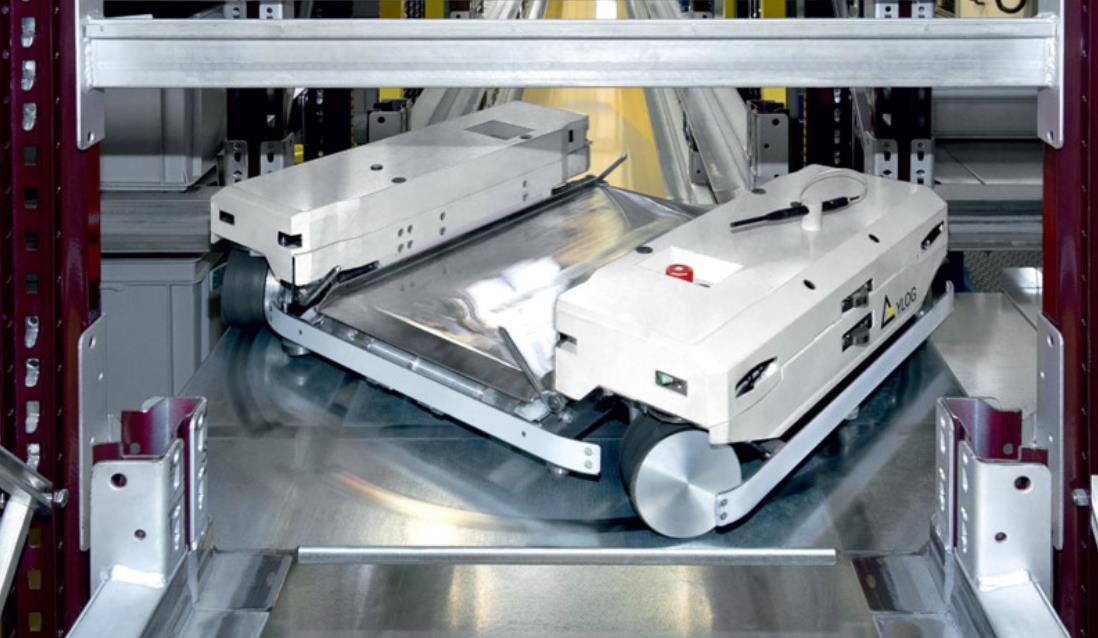The use of pallet shuttles in automated warehouses
A pallet shuttle, also known as a pallet shuttle system or pallet shuttle robot, is a motorized device used in warehouses and distribution centers to automate the storage and retrieval of palletized goods. It is designed to move pallets within a racking system, allowing for efficient and high-density storage.
The pallet shuttle consists of a shuttle device that operates within the racking lanes, along with a remote control unit or a central control system. The shuttle is equipped with wheels or rollers that enable it to move horizontally along the depth of the racking system.

Here's how a typical pallet shuttle system works:
1. Loading: The pallet shuttle is placed at the entrance of a racking lane, and a forklift or other handling equipment loads the shuttle with a pallet.
2. Positioning: The forklift operator uses a remote control unit or a central control system to send the shuttle into the desired storage location within the racking lane.
3. Storage: The shuttle moves along the racking lane, pushing or pulling the pallet into the designated position. It can access deep into the lane to maximize storage capacity.
4. Retrieval: When an order for a specific pallet is received, the shuttle retrieves the pallet by moving it to the entrance of the lane for easy retrieval by forklift or other equipment.
Advantages of pallet shuttle systems include increased storage capacity, improved selectivity, faster throughput, and reduced labor requirements. These systems are particularly beneficial in high-density storage environments where efficient space utilization is critical.
Pallet shuttle systems can be integrated with warehouse management systems (WMS) or warehouse control systems (WCS) to facilitate automated inventory management, order tracking, and optimization of material flow.
It's important to note that different manufacturers may offer variations in the design and features of pallet shuttles, but the basic principle remains the same: they are motorized devices that automate the movement of pallets within a racking system for efficient storage and retrieval operations.
Pallet shuttles are commonly used in Automated Warehouses to optimize the storage and retrieval of palletized goods. These systems increase operational efficiency by reducing manual labor and improving throughput. Here's an overview of the use of pallet shuttles in automated warehouses:
1. Pallet Shuttle System: A pallet shuttle system consists of a series of racking lanes equipped with specialized shuttle devices. These shuttles are motorized, battery-powered devices that can move horizontally within the racking system. They are designed to carry and transport pallets within the lanes.
2. Storage and Retrieval: In an automated warehouse with pallet shuttles, pallets are stored in the racking system using the shuttle devices. The shuttles are guided within the racking lanes, allowing them to carry pallets deep into the storage system. This maximizes storage capacity and enables high-density storage.
3. Automation and Control: The operation of pallet shuttles is controlled by a warehouse management system (WMS) or warehouse control system (WCS). The system receives orders for storage or retrieval and directs the shuttles to the appropriate location. The shuttles autonomously move within the racking lanes, positioning themselves under the designated pallet.
4. High-Speed Operations: Pallet shuttles offer fast and efficient storage and retrieval operations. They can work in multiple lanes simultaneously, allowing for simultaneous inbound and outbound operations. This results in increased throughput and reduced cycle times compared to traditional manual or forklift-operated systems.
5. FIFO and LIFO Operations: Pallet shuttles can be configured to support both FIFO (First-In-First-Out) and LIFO (Last-In-First-Out) operations. By accurately tracking pallet positioning and retrieval sequences, pallet shuttles ensure the proper rotation of inventory based on the specific requirements of the stored goods.
6. Versatility and Adaptability: Pallet shuttle systems are flexible and adaptable to different warehouse configurations and pallet sizes. The racking lanes can be adjusted to accommodate varying pallet dimensions, and the shuttle devices can be easily reprogrammed or repositioned as needed.
7. Automated Integration: Pallet shuttle systems can be integrated with other automated warehouse technologies, such as conveyor systems, automated guided vehicles (AGVs), or robotic systems. This integration streamlines the flow of pallets throughout thewarehouse, enabling seamless material handling and efficient operations.
8. Improved Safety: Pallet shuttle systems contribute to improved safety in the warehouse environment. By reducing the need for forklift traffic in the storage lanes, the risk of accidents and collisions is minimized. Additionally, the shuttles are equipped with safety features such as sensors and obstacle detection systems to prevent damage to pallets or the racking structure.
9. Real-time Inventory Management: Pallet shuttle systems provide real-time visibility and control over inventory. The automated nature of the system allows for accurate tracking of pallets, their locations, and quantities. This enables better inventory management, faster order fulfillment, and reduces the chances of stockouts or overstock situations.
10. Scalability and Expansion: Pallet shuttle systems are scalable and can accommodate the growth and expansion of the warehouse. Additional racking lanes and shuttle devices can be easily added to increase storage capacity and throughput as business needs evolve.
Overall, the use of pallet shuttles in automated warehouses offers significant advantages in terms of storage density, operational efficiency, inventory management, and safety. These systems optimize the utilization of warehouse space and streamline material handling processes, ultimately leading to improved productivity and customer satisfaction.
